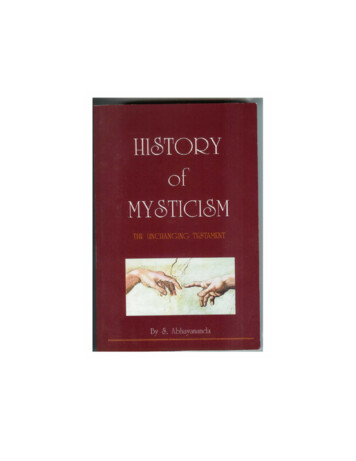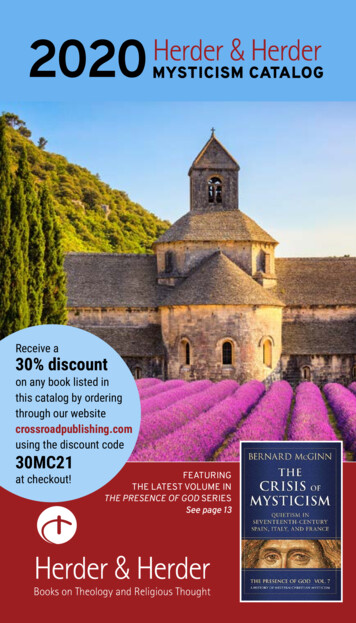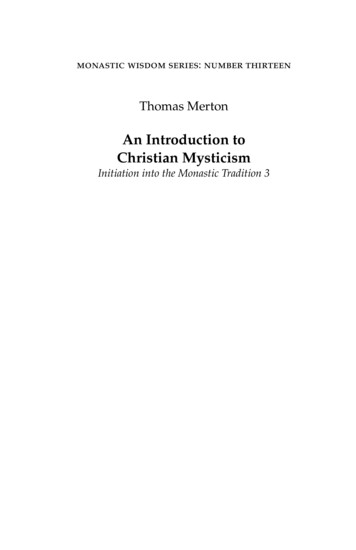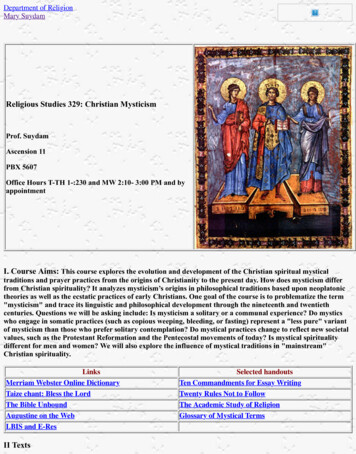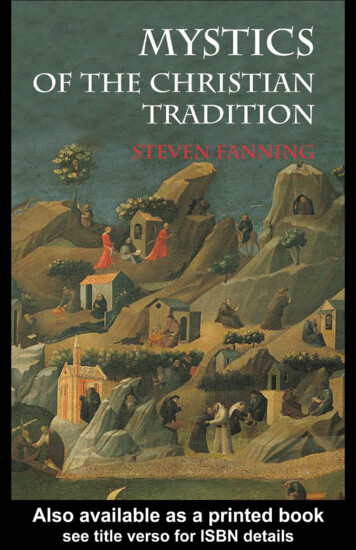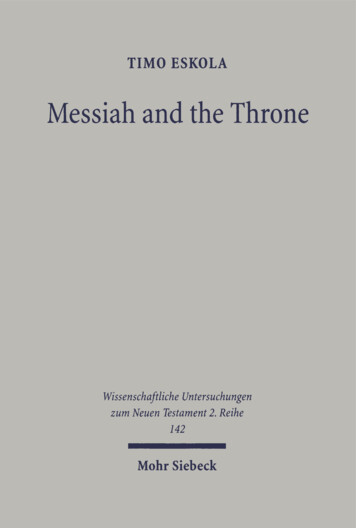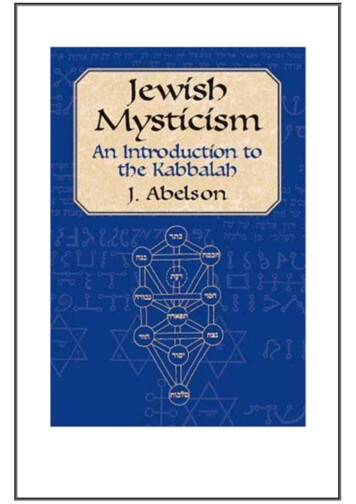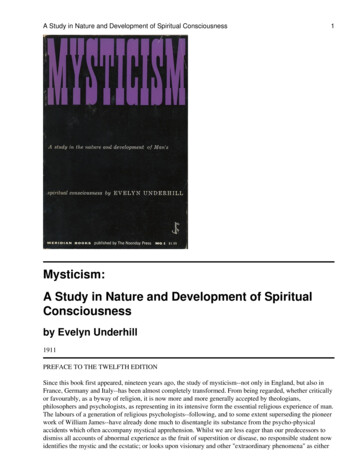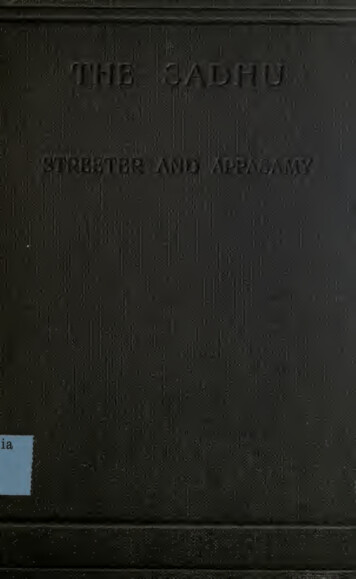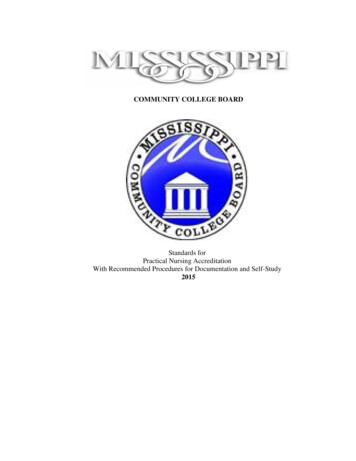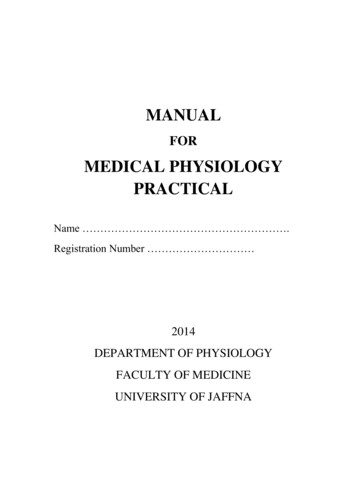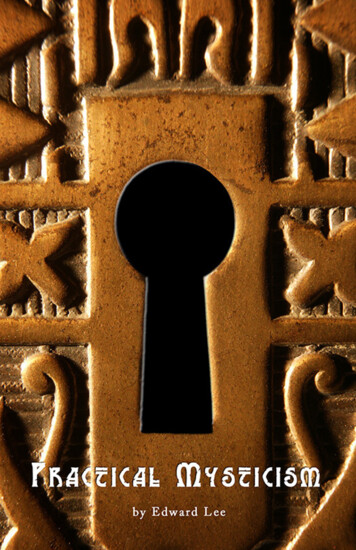
Transcription
PRACTICAL MYSTICISMby Edward Lee
2005 and 2015 Supreme Grand Lodge Of The Ancient andMystical Order Rosae Crucis. All Rights Reserved.This publication is for your personal, private use only, and may notbe used for any commercial purpose. No part of this publication maybe reproduced, distributed, displayed, or transmitted in any form or byany means, including photocopying, recording, or other electronic ormechanical means, including information storage and retrieval systems,without the express and prior written permission of Supreme GrandLodge Of The Ancient and Mystical Order Rosae Crucis, except inthe case of brief quotations embodied in reviews. For permissionrequests, please contact: Supreme Grand Lodge Of The Ancient AndMystical Order Rosae Crucis, Inc., Rosicrucian Park, 1342 Naglee Ave,San Jose, California 95191.The information in this book is distributed on an “as is” basis,without warranty. Although every precaution has been taken in thepreparation of this work, neither the author nor the publisher shallhave any liability to any person or entity with respect to any loss ordamage caused or alleged to be caused directly or indirectly by theinformation contained in this book.
CONTENTS1. Who Are You?2. The Ability to Concentrate3. Problem Solving4. Giving Advice5. Karma6. The Next Ten Years7. What Do You Suggest?8. What Is Visualization?9. Your Desire to Know10. Are You a Human Barometer?11. Are We Free?12. Setting a Good Example13. Are You Prepared for Transition?14. Thoughts About Reincarnation15. Silence
WFOREWORDHILE READING THE chapters of this book, you maywonder about several key words—such as mystic, mysticism,the Cosmic, and God—that you may have never comeacross before, or are used in a way that is new to you. Since the specificmeaning of these terms may elude you, I wish to take this opportunityto provide the following explanations that I believe will shed somelight on these subjects.Mystic and mysticism—have there ever been two words somisunderstood and maligned by various writers? Mysticism does notrefer to anything mysterious. It is not mystery. Mysticism is simplythe process by which an individual may experience direct, consciousunion with the Absolute, Divine Mind, Universal Intelligence, orwhat Rosicrucian students refer to as the God of their Hearts. It is theintimate and direct awareness of God or the Cosmic through Self,that is, through the domain of the subconscious. This doesn’t happenby adhering to specific tenets or beliefs, but by learning and applyingnatural laws that, over time, allow students to experience consciousnessof the Cosmic.What is the Cosmic? It is the divine, infinite intelligence of the SupremeBeing permeating everything. It is the totality of laws and phenomenathat manifests throughout nature—and therefore throughouthumanity—all the forces, energies, and powers that account for thefinite and infinite worlds.The mystic, then, is the student, the knowledge-seeker, who throughthe process of studying mysticism seeks direct, conscious union withUniversal Intelligence and the Cosmic. Perhaps former RosicrucianImperator H. Spencer Lewis best defined the mystic when he wrotethe following: “What actually constitutes the mystic? Wherein is thetrue mystic so different from other earthly beings? What is the essenceof mysticism that makes it so wonderful and so sacred at the same
PRACTICAL MYSTICISMtime? Is it not the conscious attunement with Divinity and the Cosmicwhich comes from the knowledge and the ability to apply and use the lawsof God and nature constructively?”A profound question which leads us to a good definition of the wordGod. Rosicrucians do not attempt to define the nature of deity, becauseeach person finds this definition within his or her own heart. God iswholly a subjective experience and thus a personal interpretation. Theconcept of God reflects the intelligence, education, religious and socialbackground of each individual. For these reasons it is impossible tocreate a uniform conception of God acceptable to all individuals alike.But most Rosicrucians feel there is but one God, ever-living, everpresent, without limiting attributes or definite form or manifestation—it is the God of our Hearts.In this book, Practical Mysticism, author Edward Lee answers typicalquestions that have been asked of correspondents, instructors, andofficial representatives of the Rosicrucian Order, AMORC, over histhirty years of employment at the organization’s headquarters in SanJose, California. The author points out that throughout those years his“answers and comments, as it turns out, were not exclusively relevantto students of mysticism but to many other persons who were seriousabout bettering their lives from the inside out. There is no doubt aboutthe fact, however, that inner self-development is a slow and gradualprocess, but ultimately worth all the effort it takes to achieve it.”And so in this spirit of discovering workable answers to age-oldquestions, let us begin to learn about the practical application ofmystical laws and principles in our everyday lives.—Robin M. Thompson, Editor—7—
—8—
Chapter 1“IWHO ARE YOU?n my life I have to please so many persons and under sucha multitude of differing conditions, that I’m having troublerealizing the true nature of my own personality. I often askmyself: ‘Who am I?’ ”The plot of an unusual film of the 1940s, entitled A Double Life,centered upon a man known to his friends and critics as being a fineactor. In this dark and gripping movie, the actor is called upon to playthe part of Shakespeare’s tragic hero, Othello. So totally absorbed inthe role of Othello does this man become that he begins to forgethis own life outside of the theater as opposed to the life of Othelloon stage. His tormented mind blurs the difference between actualityand play acting. He eventually loses complete control of himselfand believes himself to be the jealous lover, Othello. In a rage, hesubsequently commits a crime of passion one night, offstage. Since weknow that Shakespeare’s Othello takes his own life at the conclusionof the drama, the film, A Double Life, ends on a tragic note indeed.In a less dramatic way, we often feel called upon in our daily lives toassume a “role,” much as a performer on stage. We may begin our day,for example, by playing the part of the parent. We continue our day asthe commuter. We then become the worker or manager. If we attendclasses at night, we are transformed into the student. Our weekendsmay find us acting the part of the sportsman or entertainer, or perhapseven the lover.Taking into account the fact that each person has his or her ownpattern of existence, each may see self in a variety of different roles andin a myriad of acting assignments, depending on the individual. Theconviction and intensity with which we carry out these self-appointed—9—
PRACTICAL MYSTICISMroles also depend upon the performing ability of the individual. Thereasons we do these things may also vary, but it is perhaps safe to saythat we are attempting them for several reasons: to achieve a sense ofpurpose in life; to find psychological security and protect ourselves fromthe unexpected; or to maintain mental control over our environmentand, most importantly, ourselves. Nevertheless, in spite of our abilityto conform to differing social conditions, notwithstanding our willpower and acting talents, an overriding sense of futility may still hauntus. In our quieter moments, like a giant sunken ship emerging from thedepths, our real self may begin to present itself.Such a superficial restriction as society may have dictated to us whatwe should say when we speak to our children and how we should actwhen we are with our spouse. Fear often restricts our attitude at ourplace of employment, while a need for acceptance tells us what we shoulddo and think while among our friends. If our daily circumstanceschange in rapid enough succession, our role playing may resemble anold-style theatrical quick-change artist, frantically changing costumes.For example, some years ago I was able to quietly observe a colleaguein a variety of social and business situations. His kaleidoscopicpersonality changes were amazing. To his wife he was silent andreserved; to his children, rude and hostile; to his friends, a fun-lovingcomrade; to his employer, he was servile and meek; to the women onthe job he was a gallant cavalier. However, one day during a momentof clear insight, I suddenly realized the real nature of this person. Itcame as a shock. I felt the loneliness and fear that radiated from him. Irealized further that he was not totally unlike many other people—notunlike myself at that time. It was simply that role-playing was a morepronounced aspect of his character, whereas with most other personsit is partially hidden.At times of such humbling self-awareness we wonder why we insiston living a life of duplicity. We are reminded of the words of a writerwho said, “He was a chameleon and his rare capacity for recognizingwhat was required of him was equaled only by his capacity for becomingit.” We may be struck by the fact that day in and day out, year after year,we often move about in a personally directed theatrical performance.— 10 —
PRACTICAL MYSTICISMWe pretend; we play the role. Why? From what are we hiding? Which isthe real personality and which is the charade?Getting back to our confused actor and Othello, if we follow hisexample and the false face we assume is allowed to become our master,then pain is the inevitable result. That is to say, if we always permitour five physical senses to dictate to our inner selves as to how we willtruly conduct our lives, then we are in effect throwing away our anchorin this often-turbulent sea of life. If our outer self has no consciousconnection, no bridge to our inner being, then in a storm our ship hasno safe port. The practical value of a rational study of mysticism andself-knowledge cannot be overestimated.Authentic mystical teachings often refer to the evolving soulpersonality, the refinement of character, and the improvement of thewhole being. These are not generalities but instead are fundamentalreasons for the existence of such venerable organizations as theRosicrucian Order, AMORC, and others. Each sincere student onthe Path is not only unfolding the psychic centers, becoming moreintuitive and shedding unwanted habits, but is also gradually realizinghis or her place in life. It is gratifying to know that such students arein fact carving out for themselves a personal philosophy of life, onewhich will make them the happy and contented persons they long tobe. We have observed that true mystical teachings are definitely not inthe business of trying to make all of its students think exactly alike.They do not envision a giant mystical factory where, at the end of aconveyor belt, all students fall off the assembly line in a uniform way.They are not attempting to be like a cookie-cutter, but do encouragethe serious student on to independent thought and applying what islearned in a practical way.In this chapter, we have mentioned those who, for the most part, areunconsciously role-playing through life. Those who consciously do soin order to achieve a psychological dominance over the other person,or to outwit someone through duplicity and misrepresentation, are inanother category entirely. The gaining of advantage through negativemeans gave birth to the delicious axiom: “Oh, what a tangled web weweave, when first we practice to deceive!”— 11 —
PRACTICAL MYSTICISMIt goes without saying that there are people who must practice duplicity asa matter of personal survival, as in the case of law enforcement operativesand those who do so in order to save lives in dangerous situations; alsothose who are professional performers, actors, and so on. In this discussionwe are chiefly concerned with those who hide from themselves through anunconscious series of cloaks and masks so as not to face the truth aboutthemselves as they really are.So, what are the benefits of being honest with self, of courageouslyand gradually improving the personality? For one thing, it ultimatelygives us an unshakeable sense of personal identity. There emergesa most agreeable feeling of being a unique person. For another, webecome at ease with self and gradually cease the search for outwardassurances from friends and neighbors, and become a friend andneighbor to ourselves.A serious student of mysticism will hesitate to do anything that willinterfere with or destroy the newly constructed inner connection. He orshe becomes a more positive individual, free from a multitude of fears,one of those individuals who seems at ease under any circumstance.We, in turn, feel at ease in their company, as they appear to haveno counterfeit image of themselves with which they seek to impressothers. They move among both the world-renowned and the humblepoor with the same genuineness and sincerity, free of hypocrisy. Theybecome an ideal toward which others can strive.If you are looking for a guidepost in your search for self-identity andinner awakening, remember this relevant quotation from Hamlet:This above all: to thine own self be true,And it must follow, as the night the day,Thou canst not then be false to any man.— 12 —
— 13 —
Chapter 2DTHE ABILITY TOCONCENTRATEURING AN INFORMAL discussion at a Rosicruciangathering in a large American city, a woman asked: “Howdoes one finally go about achieving a greater success withall of these mental exercises that are written about in our lessons andpracticed at home?”It is a self-evident truth to say that a house should be built upon afirm foundation. When it comes to constructing a better, finer characterand a more spiritual personality for ourselves, the foundation shouldconsist of those conditions that are just as solid and strong. We referto such things as aspiration, sincerity, goal setting, and the ability toconcentrate. There are other ingredients that could justifiably be added toour abstract foundation, but at this time we wish to direct our attentionexclusively to mystical concentration.What is concentration? It is the bringing together and the directingof our thoughts to a common center. It is the gathering, the collectingof our mental energy into a single pinpoint of undiluted, intenseforce. For instance, when producing maple syrup, one concentratesthe sap by boiling it. Milk that is to be vacuum packed in a can mustbe condensed by removing the water from it. By the same token,we render our wandering thoughts less dilute by willfully rejectingthe extraneous. In fact, the word concentrate means something thatis undiluted, condensed, and therefore increased in strength. Ourconcentrated thoughts automatically become a strong force, a potentpower for good.— 14 —
PRACTICAL MYSTICISMIf you wish to see an excellent example of concentration, watch oneof those documentary films about nature that shows a lioness stalkinga zebra. You will observe the total silence, the menacing stealth, thehypnotic gaze, and the gathering of the animal body into one dynamicmass until this force and power is suddenly unleashed in a lightningstrike of great intensity. This is purity of purpose demonstrated for usin a totally natural setting provided by nature.When an artist is creating a work of art, such as a painting, heor she often enters into a mental state whereby all of the facultiesare absorbed into the project in progress. The surface plane ofconsciousness, the objective level, begins receiving information fromthe deeper subjective mental arena, and certain imaginative impressionsstart to flow. Entering even deeper into concentration upon this work,the artist passes into a state of mind whereby subconscious mentalinput is possible. The subconscious, being the most profound levelof consciousness, is in contact with the great Cosmic Mind, andinspirational ideas and impressions may flash across the threshold ofthe inner mind. Such ideas are then subjectively translated into usefulthoughts and pictures that are perhaps added to the work of art. Suchpersons are often completely oblivious of their surroundings, and ifanother person were to suddenly burst into the artist’s studio, thatwould cause the artist to be forcefully and abruptly brought back tothe surface of consciousness. As a sidelight, it is the irritated reactionof an artist at such a time that may have originally given rise to theexpression “temperamental artist.”In the example of the lioness, we witness the drawing together, thecollecting of all physical and emotional forces into a common centerof attention for accomplishing a single purpose. This is also true ofthe artist at work; here we see undiluted concentration. But amonghumans something much more vital is added, so let us consider whatthis is. As mystical students focus their thoughts on a higher conceptor perhaps some special exercise, they then begin to move graduallycloser to attunement with the Cosmic Mind. We will have more to sayabout this concept later.There are people who say that they have no difficulty at all inconcentrating, and perhaps they do not. However, such persons are— 15 —
PRACTICAL MYSTICISMfew and far between. For most of us, the ability to concentrate isdifficult to achieve and must be developed on a step-by-step basis. Likeall other art forms, there are rules, guidelines, stages of development,and personal effort involved for progress to be made. Perhaps becauseof the widely available nature of instant entertainment these days,especially in the Western world, often young people are not calledupon to discipline the mind and to mentally create, unless they areindividually interested in such matters. That may be the reason todayfor such a wide proliferation of business seminars that offer to helpadults train their minds and concentrate their thinking faculties,because success in business, as in mysticism, depends heavily upon theability to concentrate.Speaking of rules, what are some suggestions for students to followin order to improve their ability to concentrate? First, one must havea purpose for concentrating. When we speak of a purpose, we meanprimarily a single purpose. In other words, if the mind is clutteredwith six or seven conflicting ideas and goals, very little of a beneficialnature will be forthcoming from a period of concentration. Therefore,at this point, we begin figuratively to boil the water from the milk orcondense the sap to make syrup. We make our thoughts more intenseand powerful. If, for example, we wish to conduct a special exercise andconcentrate on all parts of the body, we must discard all stray thoughtsof what happened on the job today, or what we plan to have for lunchtomorrow, and so on. Then, like a beam of light that searches out andfocuses on a single spot only, we shine our thoughts on one part of thebody at a time and imagine energy and glowing health in that area; wefeel that area tingle and the energy move slowly up until we encompassour entire body with our thoughts.Second, there should be present a motive for concentrating. Thestudent should have an unselfish reason for wishing to accomplisha particular objective through concentration; otherwise the ultimateresult will not be satisfactory to the student.For example, suppose you wish to obtain a new home. You thenproceed to concentrate and use all the correct techniques for mentallycreating this new environment. However, inherent, incorporated, anddeeply embedded in that mental plan for a new home should be the— 16 —
PRACTICAL MYSTICISMthought that once it is obtained, it is going to be used, at least partially,for the benefit of others. You may foresee a larger environment inwhich your children or perhaps grandchildren might visit from time totime. You may visualize more suitable rooms for accomplishing someworthwhile goal. For example, an artist may need a larger, quieter,better-lighted environment to create beauty for others to enjoy.Third, tied in closely with your motive, is deservedness. In using theword deserve, we mean that enormous ebb and flow of Cosmic Law thatpermeates all nature and pulsates through our lives. For example, it mayvery well be that the home we are visualizing and concentrating uponwith all our heart and soul may not actually be in our best interests toreceive at this time, and the Cosmic will not cooperate and help bringabout a manifestation the way we wish it to.Before continuing, we must point out that this principle appliesparticularly to those mystical students who are sincerely interested inworking harmoniously with the Cosmic Mind. In such cases it appearsas though the Cosmic, instead of aiding students with their plans, doesnot assist in fruition. Students may be disappointed that their plansare not working out, but perhaps months or years later, they will lookback and be eternally grateful to the Cosmic that these plans did notcome about. “Man proposes and God disposes” may be another wayof explaining deservedness.To summarize: Discipline the mind; insist within that there will bebut a single thought upon which you will focus your attention. Discardall extraneous and wandering thoughts that come to the mind. You willfind that the power to accomplish such strong concentrated thoughtwill gradually become easier as you practice this forceful focusing ofthe mind.Next, we must be unselfish, at least to some degree, in the desire forsuccess in mystical experimentation. Intrinsically wound up in thedesire for success must be the willingness to be of some service tohumanity.The final stage of mystical concentration is where concentrationends and inner attunement becomes truly dominant. In other words,— 17 —
PRACTICAL MYSTICISMat this stage the student has already filtered out all useless thoughtsand is working with a single objective only. The conscience is clear,and he or she has the correct attitude of humility. Next, the studentshould exercise force of will to dismiss the single thought and allowthe subconscious mind freedom to receive intuitive impressions.Up to this point, the student has been concentrating. However,when the student stops objective thinking, releases the thought whilein that borderline state, he or she begins to meditate. In this context,attunement and meditation are synonymous terms. Some persons enterinto this state of attunement without willfully attempting to do so, asin the case of the artist spoken of earlier. At such times, helpful andinspirational ideas often flash into consciousness, bringing with them athrill of renewed enthusiasm and pleasure. Such ideas or impressionsare ultimately practical and useful in daily life.Therefore, it may seem contradictory to say this, but successful mysticalconcentration includes ultimately the ability to stop concentrating, andthe willingness to submit within to the meditative state.Finally, as far as utilizing the Rosicrucian ability to concentratefor such activities as thought transmission and related phenomena,authentic mystical tradition gives this definite precautionary advice:The Cosmic will not carry your thoughts for any destructive, unfair, orunethical reason. There is no inexplicable magic in this; it is simply good,clean, honest transmission of thought power, and it needs the cooperationof the Cosmic to bring it about. The Cosmic will not help you do anythingthat will injure or hurt anyone.— 18 —
— 19 —
Chapter 3TPROBLEM SOLVINGHERE ARE ANY number of reasons why we experienceproblems in our lives: a lack of understanding of a givensituation; insufficent control of our emotions; overemphasison one minor condition; underemphasis concerning a more seriousmatter; and so on. The ways and means by which we deal with ourproblems often have far-reaching effects on our lives and the lives ofthose around us.We might say that a problem is an unsettled matter demanding asolution, or at least a decision. It is normally an issue that requiresconcentrated thought or personal skill for its satisfactory solution. Itusually entails doubt, uncertainty, and sometimes fear. There are variouskinds of problems, such as social problems, problem neighborhoods,or problem children. The type of problem that we will focus on in thisdiscussion is personal problems and their means of solution, usingmysticism as a practical tool for accomplishment.Problem solving has become a basic kind of thinking and has receivedmuch study by psychologists and other students of human behavior,such as students of the Rosicrucian Order. Problem solving activityfalls broadly into two categories: one emphasizes simple trial anderror; the other requires some degree of what is sometimes referredto as insight. The mystical connotations of this latter method shall bedeveloped shortly.In trial and error, the individual proceeds mainly by exploring andmanipulating elements of the problem situation in an effort to sort outpossibilities and to run across steps that might bring him or her closerto the goal in mind. Trial and error activity is not necessarily overt, asin one attempting to fit together pieces of a jigsaw puzzle. It may be— 20 —
PRACTICAL MYSTICISMyou, as the one attempting to solve your problem, simply reflectingon the dilemma and mentally testing possibilities. You may put fortha certain amount of intellectual exertion aimed at finding an answerto your question, or at least a means of achieving a desirable, practicalgoal. You want peace and harmony to reign within, with respect to theparticular problem you have in mind.You may decide to resort to the method utilized in some researchinstitutes—namely, the use of diagrams to assist you in seeing thewhole situation in a clearer light. Diagrams can be used as guidesto explore the overall structure of a problem and to reveal possiblecourses of action that might otherwise be missed. In some cases youmay realize, upon studying your schematic, that your problem situationis too complicated to solve immediately. You may then find it necessaryto approach your problem, in steps and degrees, rather than in a singlemove.Before going any further, let us not forget the extreme importance ofidentifying our final objective. If your objective is vague, too general, oreven overly idealistic, you may never arrive at a satisfactory conclusion.Therefore, your goal must be realistic, sufficiently clear, and preciseenough to serve as your basis upon which to proceed. Unless yoursituation has been well explored by you, choices are not likely to beobvious once your work begins. Thus your first move is to develop asclear a formulation of your objective as possible. You may even findit necessary to consult with one or more persons whom you considerqualified in your area of concern at this stage. But the question of youroverall objective should never really be out of your mind.It is interesting to note at this point that some secondary schoolsin Europe, as well as some elementary schools in the United Statesand England, emphasize problem-solving techniques as a regularpart of their curriculum. This provides children with the skills andattitudes to locate, define, and analyze problems as found in schoolor in community life. Extracurricular activities, such as student clubsand student government, serve to reinforce problem-solving skills.This becomes an additional frame of reference to the students forunderstanding to some extent what is expected of them in later life.This makes them more fully equipped as future world citizens.— 21 —
PRACTICAL MYSTICISMThose who are creatively endowed often decide that the best solutionto the problem they have in mind, if it is of sufficient intensity andgeneral interest, is to write a play, novel, or essay that exposes andbrings to light in a realistic manner some actual social ill. Such themesas racism, anti-Semitism, female emancipation, greed, or corruptionhave all been dealt with extremely effectively by several writers. Protestsongs or propaganda plays often stimulate thought and discussionon the part of the audience. These provide encouragement, whichrelieves, to some extent, the pressure of the problem which plaguedthe creator of the art form.Regarding the use of intuitive insight on personal problems, we mustfirst stress that you should have a clear understanding of the variousprinciples or factors that bear on the problem and solution sought.You then actively consider what is required by the problem—that is tosay, you note how its elements seem to be interrelated and seek somerule or guideline that might lead directly to the goal. Mental disciplineand a willing flexibility should characterize your thinking as you guideyourself step by step according to your plan, and altering the planitself, if need be, as you move toward a solution.But there often comes a time when we are “stumped” for a solution.Even after the keenest and most penetrating consideration of aproblem, we seem at a loss for an answer. At that point we shouldconsider letting the problem go and handing it over to a HigherJudgment. In other words, we should release the entire issue to thesubconscious mind for help and guidance. This is, admittedly, not aneasy thing to do. Humans tend to want to hold on to problems and seekguidance from the reasoning mind only.However, if we do successfully release our problem to our innerself, this greater guide within will at some time—be it hours, days,or weeks later—bring forcefully to our conscious mind an exaltedjudgment concerning our problem. The solution or method to proceedwill seem completely right. We will entertain no doubts or hesitancyconcerning the information given. In addition, there will be a kindof upliftment of our emotions or an excitement accompanying themessage. The intuitive knowledge will either flash suddenly into theconsciousness or slowly unfold in mind in progressive stages. This is— 22 —
PRACTICAL MYST
to students of mysticism but to many other persons who were serious about bettering their lives from the inside out. There is no doubt about the fact, however, that inner self-development is a slow and gradual process, but ultimately worth all the effort it takes to achieve it.” And so
